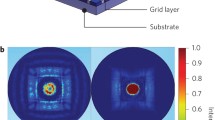Abstract
Outcoupling enhancement methods for organic light-emitting diodes (OLEDs) have been studied using anode and cathode buffers. The outcoupling of OLEDs is enhanced by using thin, high-refractive-index anode buffers, such as 25-nm and 50-nm tungsten-oxide layers and 15-nm titanium-oxide layers. Thick or low-refractiveindex anode buffers reduce outcoupling. OLEDs with 1-nm and 1.5-nm magnesium-fluoride cathode buffers have higher outcoupling than do OLEDs with 0.5-nm cathode buffers. Thin, high-refractive-index anode buffers enhance the extraction of light from the waveguide modes of the anode. As the anode buffer thickness increases, additional waveguide modes form in the anode buffer layer itself and the outcoupling is reduced. Therefore, the thickness of the anode buffer layer should be optimized within a range that does not generate additional bound modes.
Similar content being viewed by others
References
S. Nowy, J. Frischeisen, and W. Brütting, Proc. of SPIE 7415, 74151C (2009).
K. Hong and J.-L. Lee, Electron. Mater. Lett. 7, 77 (2011).
T.-Y. Cho, C.-L. Lin, and C.-C. Wu, Appl. Phys. Lett. 88, 111106 (2006).
R. Meerheim, R. Nitsche, and K. Leo, Appl. Phys. Lett. 93, 043310 (2008).
Y. R. Do, Y.-C. Kim, Y.-W. Song, and Y.-H. Lee, J. Appl. Phys. 96, 7629 (2004).
Y. R. Do, Y. C. Kim, Y.-W. Song, C.-O. Cho, H. Jeon, Y.-J. Lee, S.-H. Kim, and Y.-H. Lee, Adv. Mater. 15, 1214 (2003).
S. Moller and S. R. Forrest, J. Appl. Phys. 91, 3324 (2002).
H.-Y. Lin, Y.-H. Ho, J.-H. Lee, K.-Y. Chen, J.-H. Fang, S.-C. Hsu, M.-K. Wei, H.-Y. Lin, J.-H. Tsai, and T.-C. Wu, Opt. Express 16, 11044 (2008).
T.-W. Koh, J.-M. Choi, S. Lee, and S. Yoo, Adv. Mater. 22, 1849 (2010).
T. Nakamura, H. Fujii, N. Juni, and N. Tsutsumi, Opt. Rev., 13, 104 (2006).
R. Bathelt, D. Buchhauser, C. Gärditz, R. Paetzold, and P. Wellmann,, Org. Electron. 8, 293 (2007).
Author information
Authors and Affiliations
Corresponding author
Rights and permissions
About this article
Cite this article
Lee, HN., Cho, H.J. Buffer layers to enhance light outcoupling for organic light-emitting diodes. Electron. Mater. Lett. 9 (Suppl 1), 49–53 (2013). https://doi.org/10.1007/s13391-013-3183-2
Received:
Accepted:
Published:
Issue Date:
DOI: https://doi.org/10.1007/s13391-013-3183-2




